I titled this as a review, but the fact is it will be as much history lesson as regular review.
You see, they don’t make the 910 anymore. And haven’t since about 2006. So why am I writing about it?
Well, I have one. It’s a good gun and I’ve thoroughly enjoyed every shot I’ve fired with it. It’s accurate, reliable, and has minimal recoil.
Table of Contents
How did I come by this?
I walked into a gun store one day, and it looked like someone had raided a Smith & Wesson museum. They had quite a few semi-autos from the 80’s and 90’s, up into the mid-2000’s.
They were mostly in the model 439 (3900) and 459 (5900) tree. Both of those were 9mm; the 439 was single-stack and the 459 double. Capacities were somewhat less than today, even though those were compact guns with 4″ barrels.
Some of them were fairly inexpensive and some weren’t. I decided to pick one up, and I went with one of the less expensive options. It was mostly going to be a safe queen and I had no idea how good the gun would be, so expensive was right out.
A little history.
This gun came out in 1995. You may recall that the assault weapons ban, with its magazine capacity restrictions, went into effect in 1994.
The name 910 refers to 9mm, 10 round capacity. After 2004, when that useless piece of legislation sunsetted, they started producing 15 round capacity magazines.
I’m not sure when it happened, but at some point they started making 17 round magazines.
The gun itself.
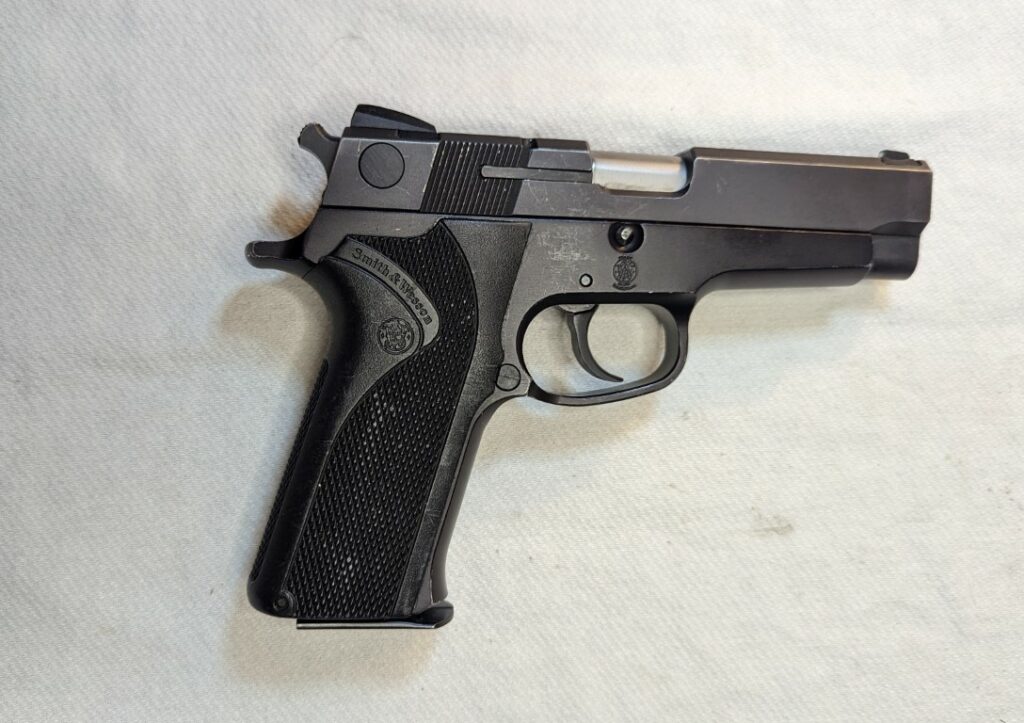
The 910 is one of the successors of the 5900, but it was considered a “Value series” pistol. That is, there were a few cost-cutting measures. The final finishing was less polished than the “normal” ones. The guide rod is plastic, as are the sights and the magazine release. The decocker/safety was only on one side, not ambidextrous.
None of those things seems to have had a negative impact on how it shoots.
Most of those old Smith’s were hammer-fired, DA/SA guns. While I may often carry a striker gun, I prefer hammer-fired. And DA/SA makes a lot of sense to me. My Sig SP2022 and CZ RAMI are both in that category.
While the trigger on the Smith isn’t quite in the Sig or CZ league, it’s not bad at all. I’d say it’s as good as some of the Berettas I’ve fired.
Details
As I said, it’s a hammer-fired DA/SA pistol. Double-action trigger pull is 10 lbs, 6 oz. per my Lyman trigger gauge. Single-action is a nice, crisp, 5 lbs.
The lever on the slide is both a safety and a decocker. Push it down, and it drops the hammer and activates a safety. I always immediately push the button back forward to disengage the safety. An over 10 lb trigger is enough of a safety to me. The picture below is the gun in its normal state.
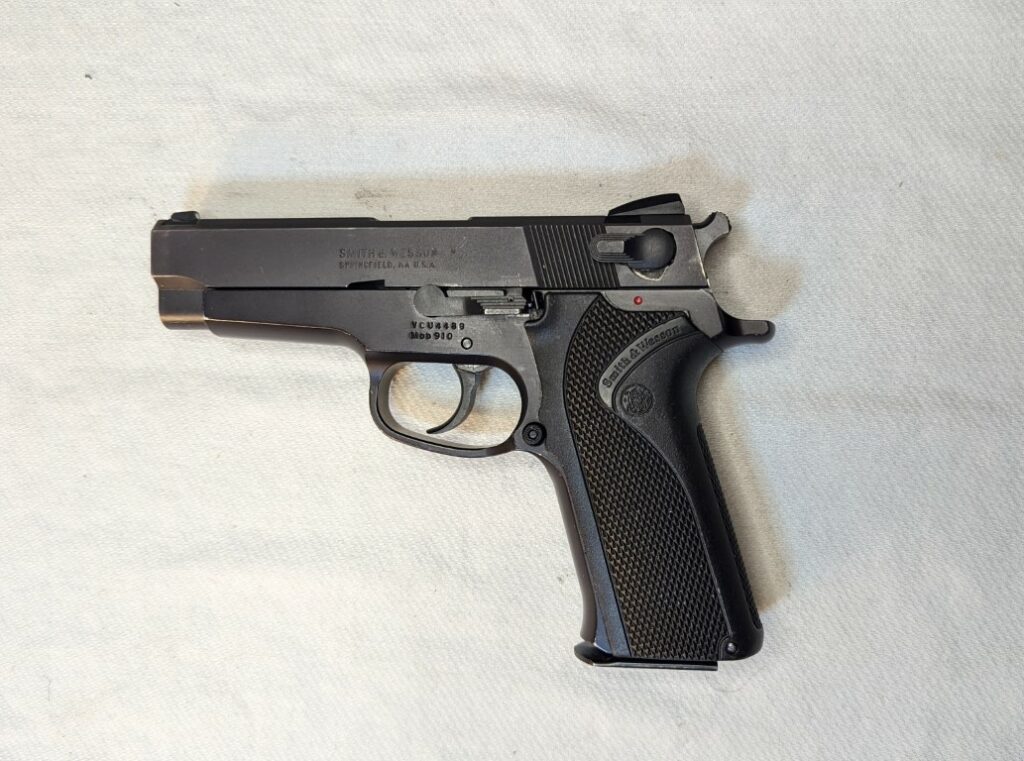
I’ve seen other reviews and videos of this that talk about 15 round magazines. Not sure where they got theirs, but mine came with a 17 round mag. I’ve since purchased two other 17 round magazines.
It has a 4″ barrel and the 17+1 round capacity I mentioned.
Width at the slide is 1″ even, 1.2″ at the grip. Height from bottom of grip to the top of the rear sight is 5.4″ Length, 7.5″.
Empty weight is 28 oz., loaded 35 oz.
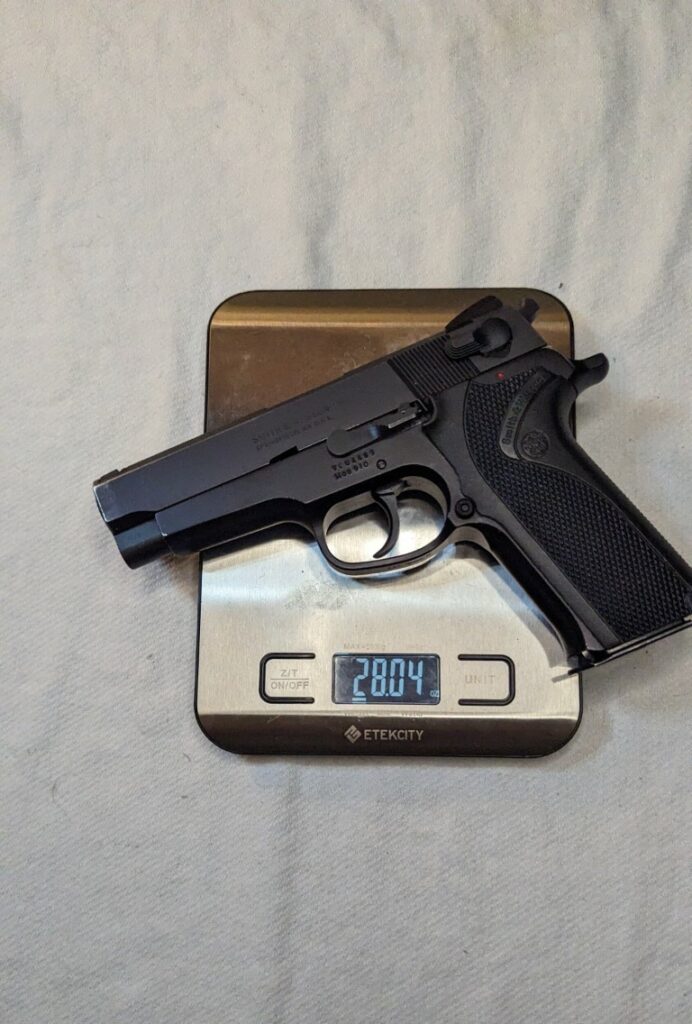
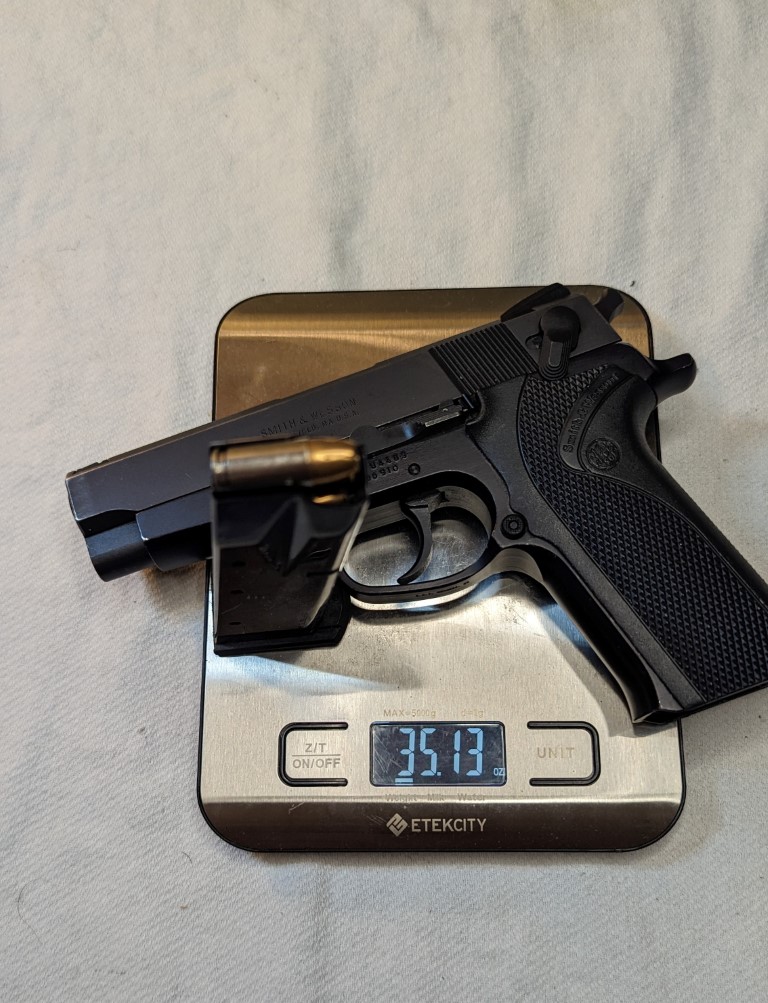
The grip texture is nowhere near as aggressive as some more modern guns. Its weight also helps soak up recoil, so maybe the grip’s lack of texture isn’t that important.
They don’t make it anymore. What’s it good for?
You know when you ask someone about budget guns, and they tell you to buy a good used one, instead? This is that gun.
I spent about $300 on it. For that, I got a 17-round 9mm that has never malfunctioned. That is the first criteria of a defensive firearm, yes? It works all the time?
It’s also accurate enough. Below is a picture of a target I shot yesterday. It’s not that impressive, but that’s more me than the gun. I really haven’t shot it that much lately. Range was 10 or so yards.
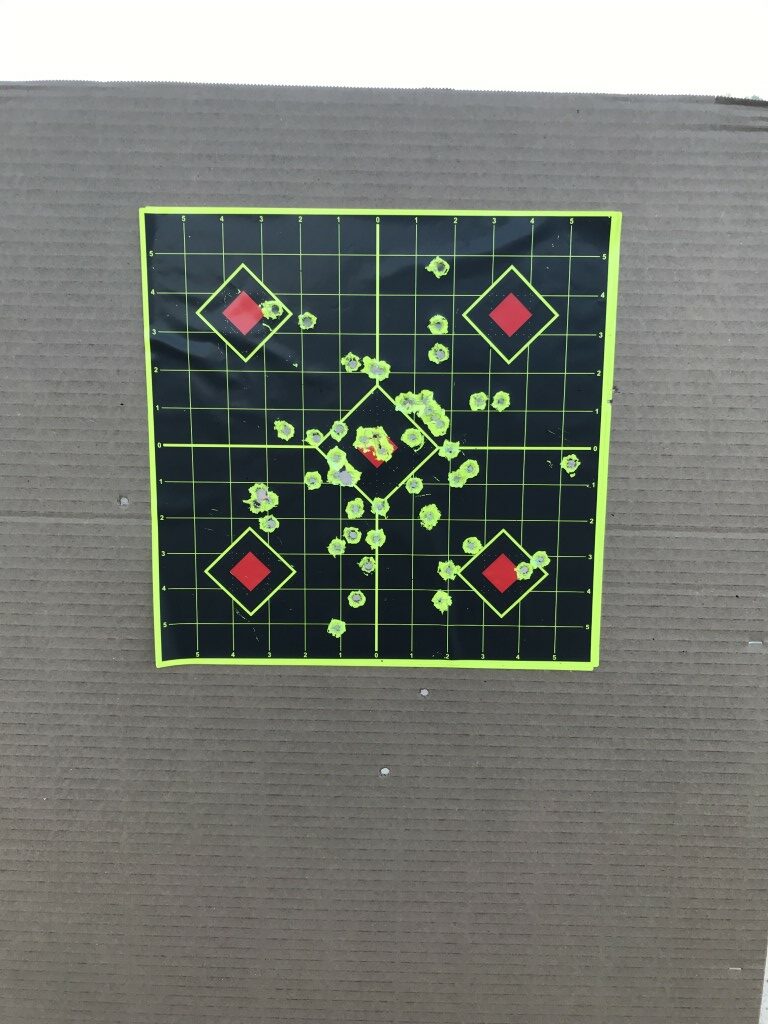
That’s a 10″ target, and I put all three magazines through the gun. Two of them were loaded with 124 gr FMJ’,s and one had Federal 124 gr HST’s.
As I said, not impressive. Adequate in a defensive situation? Yes, it is.
I think it’s also excellent for home defense, where its size isn’t a big deal. The only downside to that is that has no provision for a light. No rail on the front.
For me, I use this one. With this on it. If the 910 could take the light, I might very well use it instead of the Springfield.
Anything to watch out for?
There are a couple things.
First, disassembly isn’t quite as slick as some more modern guns. It involves lining up the notch you can see in the slide with the front part of the slide stop. Then removing the slide stop. I’ve heard rumors that it gets easier, but in mine I still have to use a tool of some kind to push it out; my finger is insufficient.
Then you need to have your hand wrapped around the bottom of the slide as it comes through. Why? So the plastic guide rod does not take off across the room on you. Sometimes it stays in place and sometimes it doesn’t. Best to be sure.
See the barrel still in the slide? That tiny little sliver moon cut there? That’s where the guide rod sits. When it’s assembled. Doesn’t always stay there when apart.
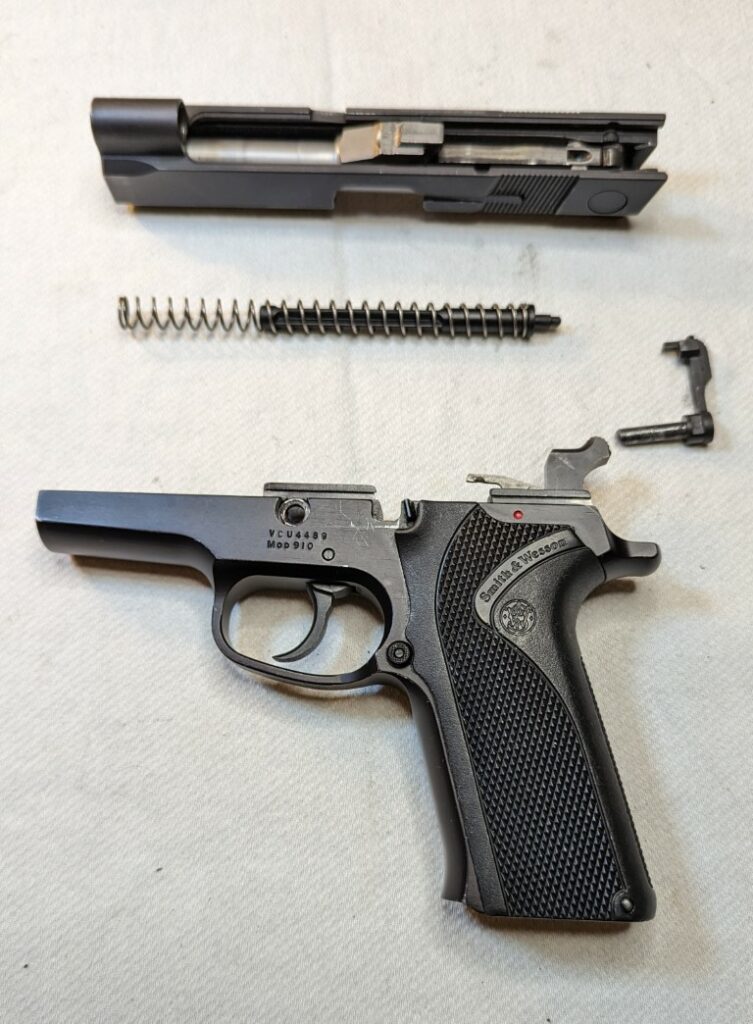
Reassembly has its own trick. In the picture below, look at the three shiny metal pieces near the hammer. They’re all spring loaded and they all have to be pressed down to get the slide back on.
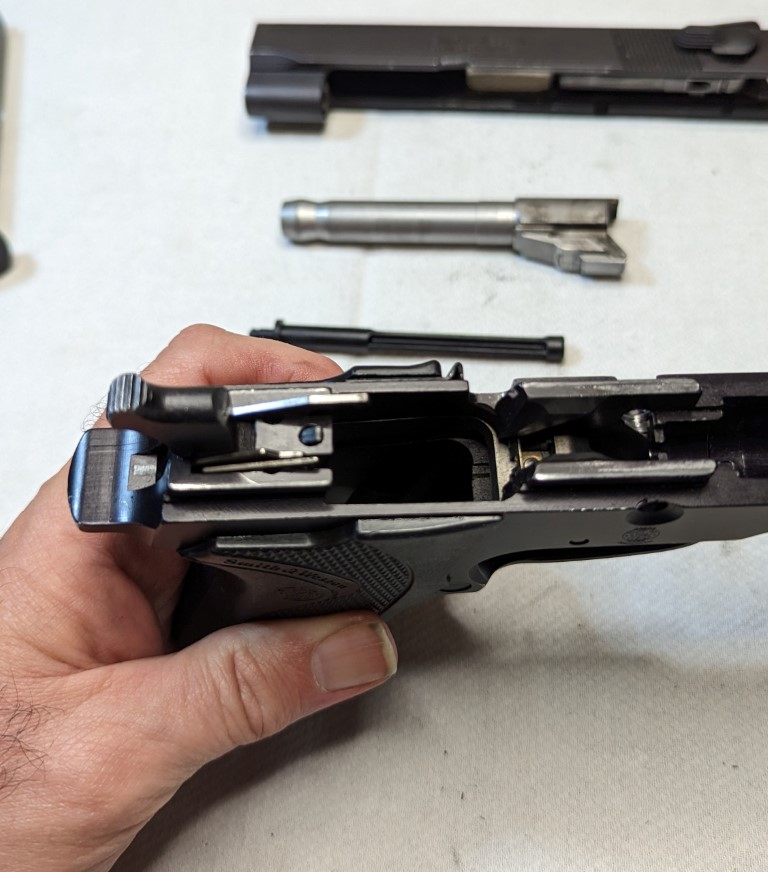
Also, you should put the slide back on with your hand wrapped around the bottom for the same reason you did so taking it off. Finding that black guide rod can be interesting.
It has a magazine disconnect. Take that for what it’s worth. A few people like them, most don’t. I’m kind of ambivalent about the whole thing but I wanted to mention it.
Finally, I’m not sure it’s a downside as such, but DA/SA does take more practice than other types. The good news is that some of it can be dry fire. My personal view is that it’s the double-action part that’s tricky. I don’t really find the transition between the two pulls all that tricky.
Accessories and parts.
Smith made a lot of these. Most of the parts that work for the other, more expensive guns, work just fine here. So if you want or need better sights or a metal guide rod, you can find them.
As for magazines, a quick search found some in the $25 range; they fit the 5900, 910, 915, and 6900 guns (Smith’s numbering system back then seemed to involve a dart board.)
Same with holsters. A holster that fits any of those models fits them all.
Conclusion.
As I said, this is a great gun. It’s not much of a carry gun for me, since I live in a warm climate. For those of you who can carry a full size, it’ll do well.
I also consider it great for home defense; its lack of a rail is what keeps it from my nightstand.
I have a 915 , also a value series pistol ,but with 15 round magazines. They were built from 1992-1994……then came the 910 in 1995 with more plastic parts. They are fantastic pistols, all around excellent. for home defense, target , self defense . Only concealed carry being difficult due to the size and weight.
I agree. I’m so glad I found this pistol when I did. I use it at the range regularly to practice my DA/SA trigger proficiency.